CustomGPT vs No Code AI Chatbots: Best Choice for 2025
no-codeMany developers and startups compare CustomGPT and no code AI chatbot tools to decide whether to build in-house or adopt a pre-built platform.
This guide is designed to help you quickly figure out which solution fits your needs best.
We cover a feature overview, use cases, customization, pricing, integrations, AI capabilities, customer reviews, pros and cons, and a final verdict on which tool to choose.
Let’s dive in 👇
The #1 no code AI chatbot: Big Sur AI
d you consider Big Sur AI instead?

Reason 1: No setup, instant launch
Instead of spending hours uploading docs or manually training a chatbot, Big Sur AI comes with ready-to-go, industry-specific bots. Real estate agencies, SaaS startups, or e-commerce teams can launch live support for FAQs, onboarding, and scheduling in minutes.

Reason 2: No tech headaches or developer dependencies
Big Sur AI eliminates API wrangling, webhook setup, and third-party integration work. Teams with no IT resources can simply add Big Sur AI to their site and start solving user questions instantly, without risking future technical debt.
The chatbot will automatically scan your documentation and website data to deliver highly accurate responses to complex questions.

Reason 3: Predictable, flat-rate pricing with no surprise costs
Unlike Chatbase’s message tiers or Intercom Fin’s per-resolution billing, Big Sur AI uses a single monthly price regardless of chat volume. This makes budgeting straightforward even during high-traffic product launches or busy support periods.
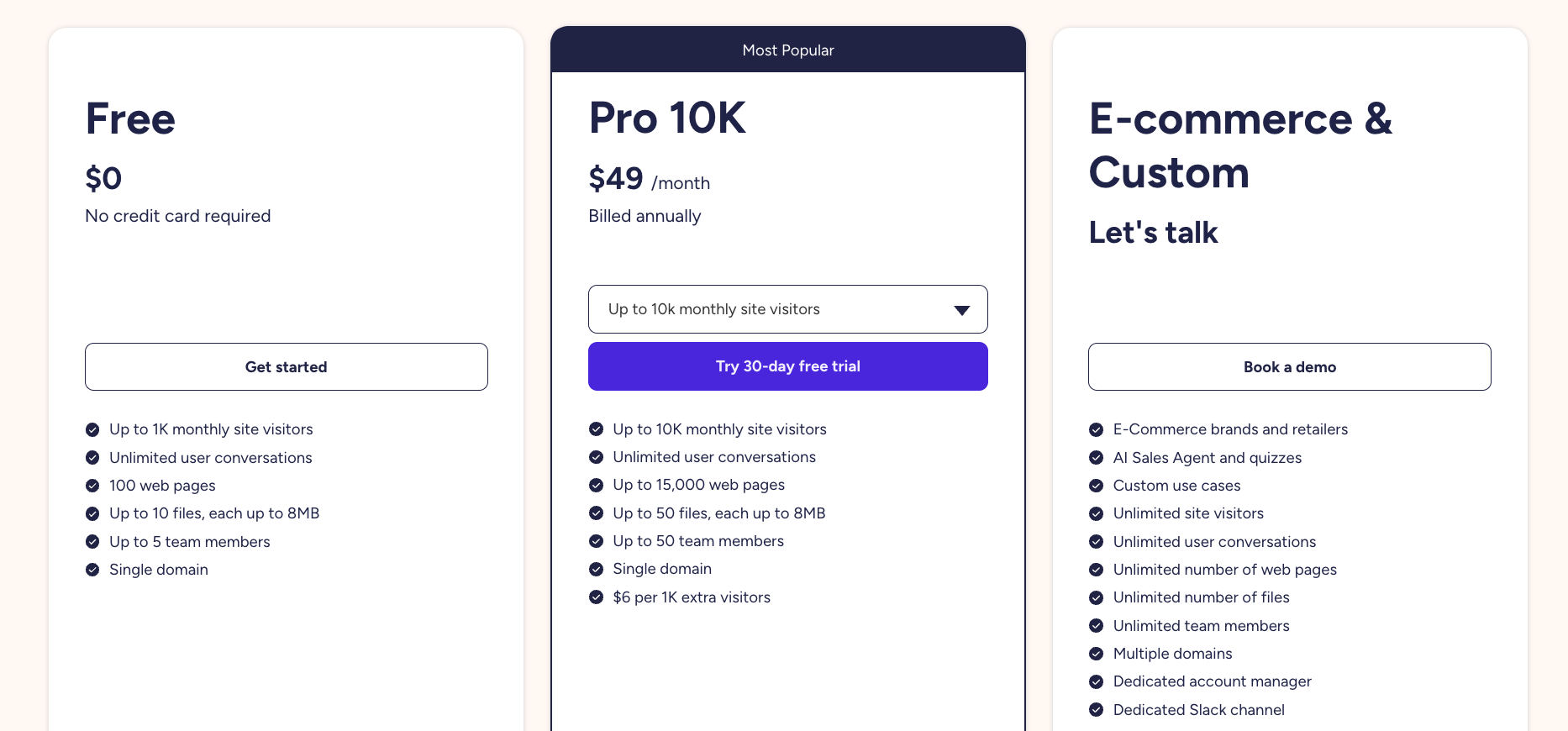
Reason 4: Custom-trained chatbot with agentic workflows
Big Sur AI trains on your own website pages and documentation data. Anything you can feed it.
The result is an AI chatbot that can give super-precise and accurate responses to complex questions.

The chatbot can also fire agentic workflows when conversations match certain contextual criteria.

CustomGPT vs No-code AI chatbot tools: Overview
| Factor | CustomGPT | No code AI Chatbots Tools (e.g. Botsonic, Chatbase, Landbot, Tidio, Crisp, etc.) |
|---|---|---|
| Public reviews | 4.7 ⭐ (G2), 4.8 ⭐ (ProductHunt) | Mostly 4.6–4.8 ⭐ (G2, Capterra) per tool |
| Our rating | 9/10 ⭐ | 8/10 ⭐ (average across popular tools) |
| Core purpose | Rapid deployment of custom, business-trained chatbots leveraging GPT/LLMs on your own data | Visual, no-code chatbot creation for websites, support, marketing; often template-driven |
| Best for | Businesses needing advanced, data-grounded, brand-specific chatbots without coding | Non-technical teams, SMBs, rapid MVPs, lead gen, and basic support bots |
| Typical use cases | Custom-trained AI for internal knowledge, customer support, documentation Q&A, product assistance | Website chat widgets, FAQ bots, lead capture, simple support, onboarding flows |
| Hosted vs self-hosted? | Fully hosted (cloud SaaS); no self-hosting | Mostly hosted (SaaS); some (e.g. Botpress) offer self-hosted options |
| Open Source? | No | Rarely (majority no; some alternatives like Rasa or Botpress have open-source options) |
| Pricing model | Monthly/annual subscription, usage-based (starts ~$99/mo, more for team/enterprise) | Varied: Free tiers, seat-based, usage-based, or by features (range: $0–$400+/mo) |
| Free plan? | Yes (limited features, messages, or data per month) | Yes (most offer free or trial plans with limits) |
| Customization level | High—custom context, business data ingestion, persona, workflow triggers | Medium—mostly visual drag-and-drop logic and UI tweaks; limited backend & LLM logic |
| Ease of use | Moderate—guided setup, but some technical/business context required for best results | Easy—anyone can build and deploy a bot in minutes, minimal learning curve |
| LLM integrations | Multiple: OpenAI (GPT-3.5/4), Azure OpenAI, some support Anthropic/Claude | Tool-dependent: Often OpenAI; some support Google, Anthropic, Cohere |
| Other integrations | Zapier, API/webhooks, Slack, Teams, basic CRM support | Varies widely: Zapier, Hubspot, Facebook, WhatsApp, Google Sheets, webhooks, more |
| Workflow capabilities | Advanced: Custom triggers, API calls, document search, retrieval-augmented generation (RAG), prompt chaining | Basic to moderate: Drag-and-drop flows, forms, conditional branching, simple API calls (premium plans) |
| Deployment options | Web widget, API, embeddable iframe, Slack, Teams, support ticketing | Web widget, pop-up, email, WhatsApp, Messenger, integrations, sometimes mobile SDK |
| Team collaboration | Yes—multi-user support on higher plans, role-based access, analytics | Yes but varies by tool—most support team access on paid tiers |
| Pros |
✅ High accuracy via business-specific training ✅ Scales to enterprise needs ✅ Deep customization ✅ Good support and security |
✅ Fast, no-code setup ✅ Great for MVPs and quick prototypes ✅ Affordable options available ✅ Lots of templates/integrations |
| Cons |
❌ No full self-hosting ❌ Higher price point vs basic bots ❌ Setup requires some business context/data cleaning |
❌ Limited backend/LLM customization ❌ Less suited for deep, proprietary data workflows ❌ Scaling/compliance limits for large orgs |
| Why choose it? | 👉 If you want advanced, scalable AI chatbots tailored to your unique business data/workflows without in-house dev or open-source deployment | 👉 Best if you need a no-code chatbot for basic website needs, support, lead gen, or to test hypotheses quickly—no dev resources required |
CustomGPT vs No-code AI chatbot tools: How do their features compare?
CustomGPTs outpace on data source flexibility and depth
CustomGPT is markedly better if you need your chatbot to ingest, reference, and interact with your own business data, whether that means PDFs, Word docs, websites, or APIs.
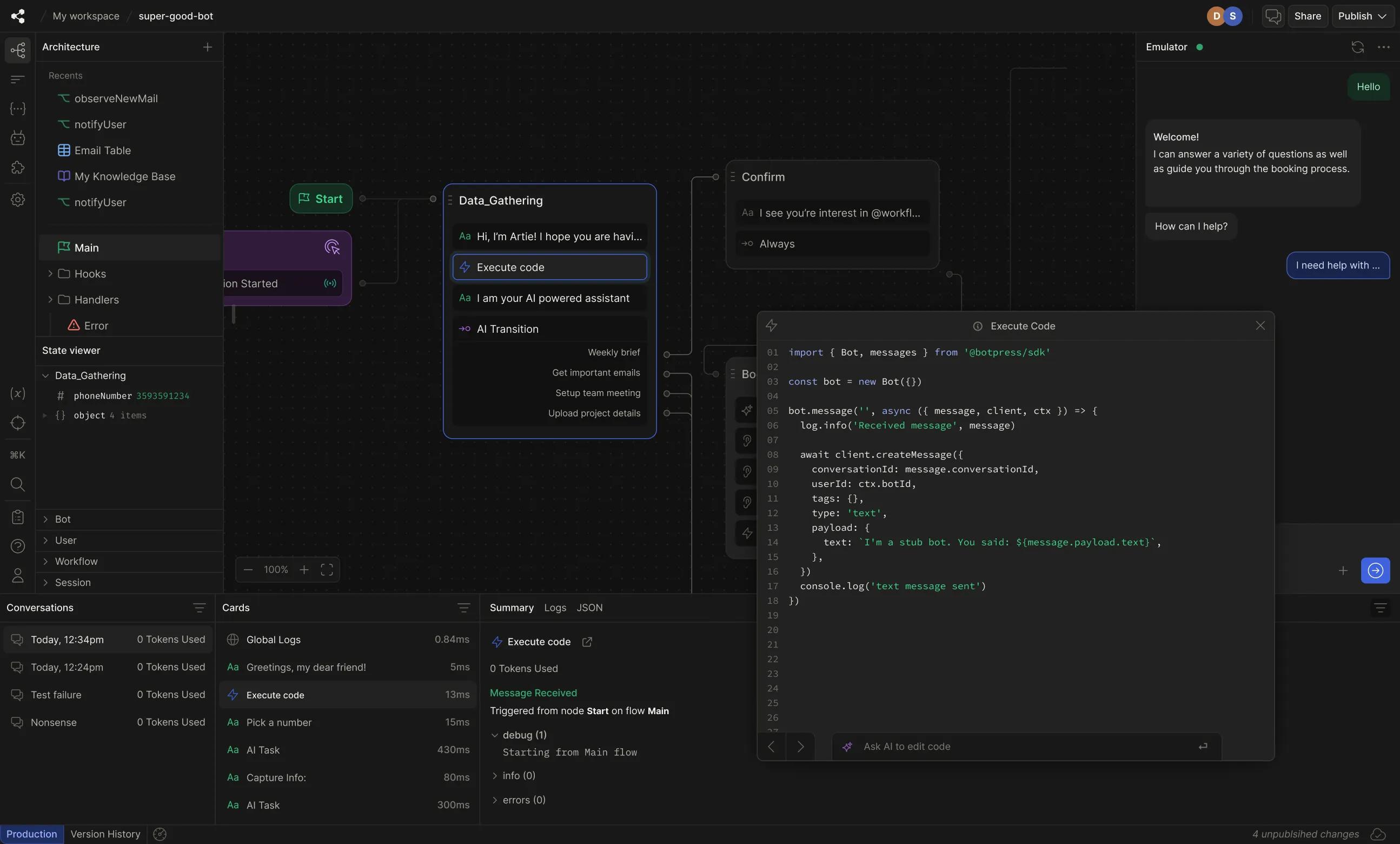
You get granular control: for instance, you can upload hundreds of product manuals, knowledge bases, or internal memos, and build a multi-source AI that answers user queries by pulling from all these proprietary documents.
In practice, this means a legal team could upload every PDF contract template they’ve ever used, and then ask the bot about specific clauses — functionality that most no code tools can’t match at this level of depth or customization.
No code AI chatbots tools are much faster for live deployment
No code AI chatbot platforms win decisively when it comes to speed to deployment.
You pick a template, feed it a few examples or prompts, set up basic user flows, and you can have a functional chatbot live on your website in minutes — no coding or technical setup required.

For non-technical teams, especially in e-commerce or support, this is a serious edge.
For example, a Shopify store owner can install a plug-and-play bot with pre-configured flows for order tracking, returns, and FAQs, all without ever writing a line of code or hiring a developer.
CustomGPT has the upper hand in conversational customization
CustomGPT lets you deeply tailor conversational flows — everything from the bot’s tone and persona, to handling edge-case logic for your business.
Beyond basic Q&A, you can define multi-step interactions, integrate custom logic, or fine-tune how the AI navigates ambiguity or conflicting data.
This makes it a favorite for businesses that require compliance filtering, branded voice, or advanced escalation triggers.
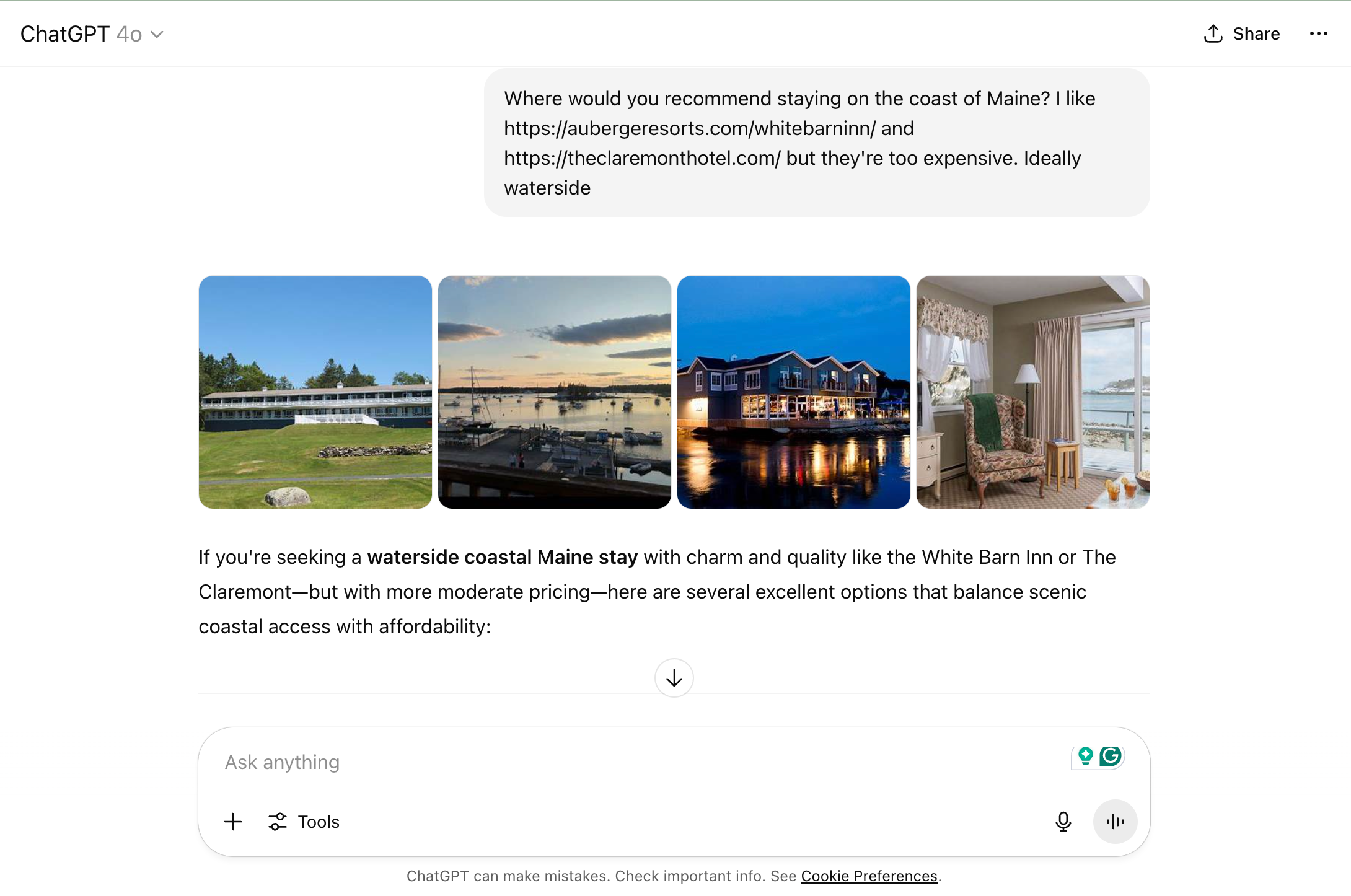
For example, a financial services firm can build a bot that never reveals sensitive details, responds only with compliance-approved language, and escalates issues to a human when the query falls outside a defined risk profile.
No code AI chatbots tools are more favored by customers for channel integrations
No code tools outpace CustomGPT when you need multichannel deployment — such as pushing your chatbot to WhatsApp, Facebook Messenger, Slack, or SMS, with just a few clicks.
Most of these platforms come with built-in connectors to popular channels, allowing you to reach your customers where they already are, with minimal technical lift.

For example, a real estate agent can quickly publish the same chatbot workflow to their website, Facebook page, and WhatsApp broadcasts without any custom coding.
CustomGPT wins on extensibility and developer control
For teams with technical talent, CustomGPT is preferred when you want to extend, programmatically manage, or integrate the chatbot with your backend systems.
It offers robust APIs, fine-grained event hooks, and the ability to embed within existing product workflows.
You could, for example, trigger automated workflows based on user data collected during a chat, or analyze conversations for sentiment and intent analysis, then push those insights to a CRM or analytics dashboard.
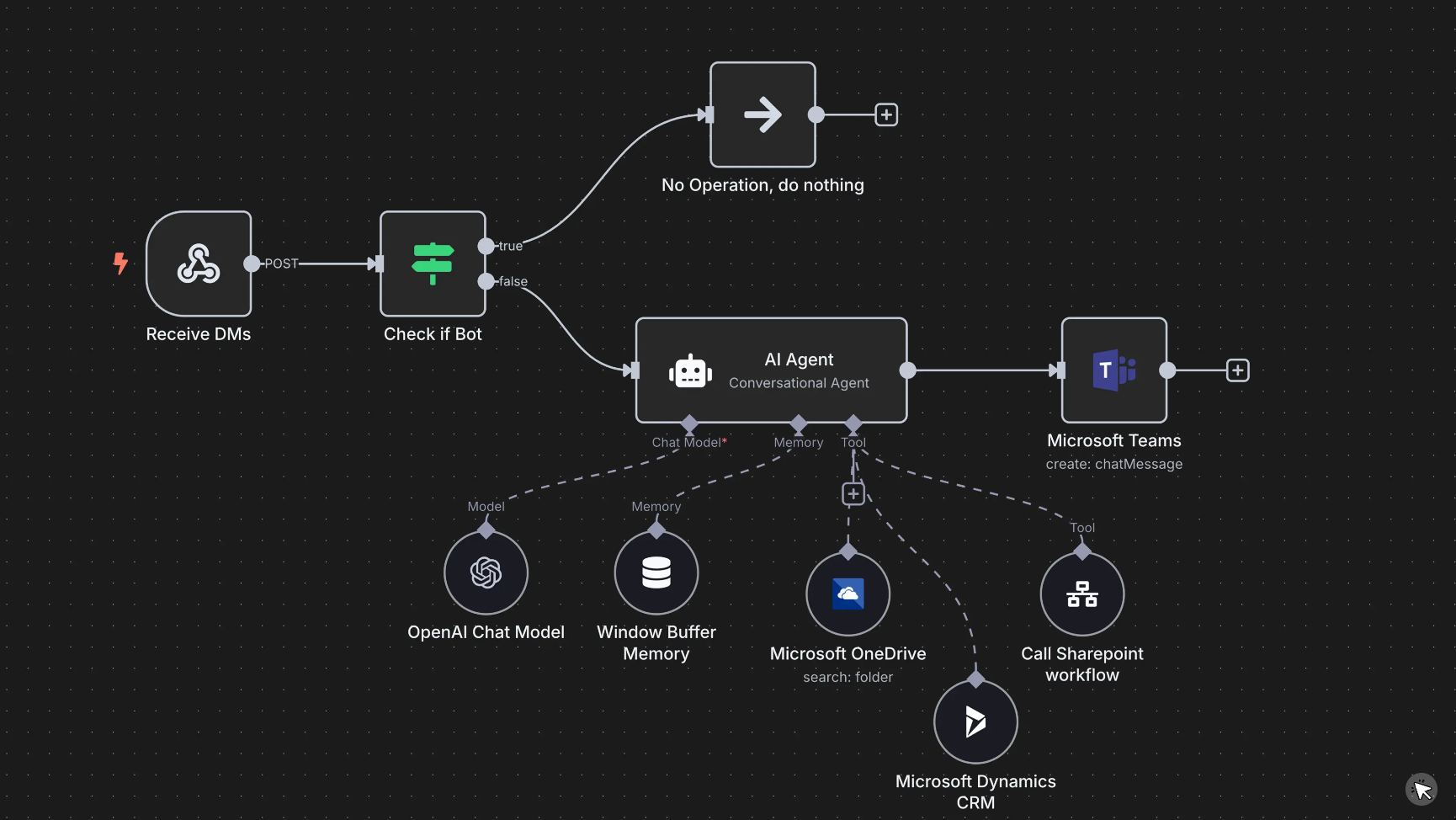
Startups often leverage this to tightly integrate with proprietary data sources, build domain-specific features, or run iterative experiments that would be impossible on fixed, template-oriented no code platforms.
No-code AI chatbots have an edge on visual workflow builders and analytics
No code chatbot tools usually include drag-and-drop visual builders that allow teams to map and edit conversational flows without touching any code.
This makes it far easier for marketing or support teams to build, A/B test, and iterate new flows, as well as to see real-time analytics about drop-off points, conversion steps, and user engagement.
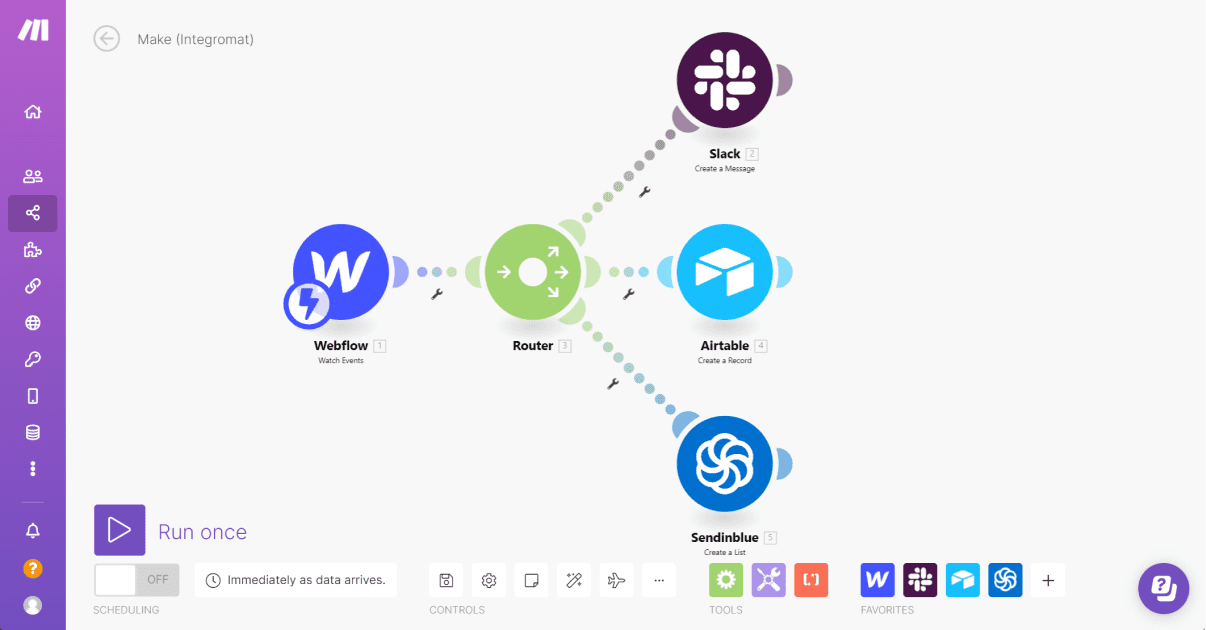
A SaaS business can observe that 30 percent of users drop off on a particular step, make the edit visually, and relaunch instantly — all from within an intuitive dashboard, with zero dependence on engineering.
CustomGPT vs no-code AI chatbot tools: How much do they cost?
CustomGPT's pricing: quick overview
- CustomGPT offers plans based on feature set, usage limits, and bot sophistication.
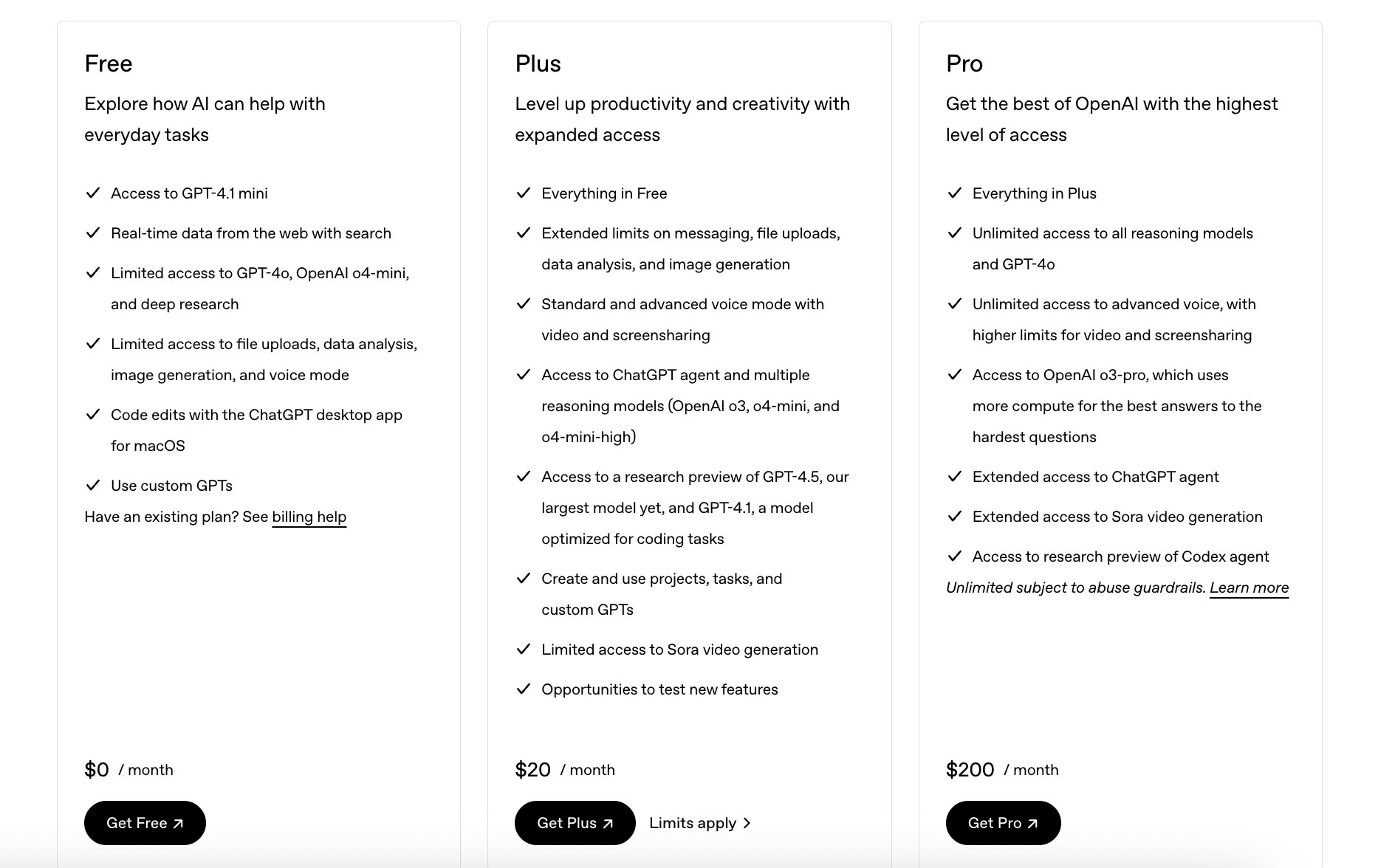
- Typical tiers (as of June 2024):
- Starter: ~$49/month. Limits on number of sources, chats, and data updates.
- Professional: ~$199/month. Expanded training/data and more chat volume.
- Enterprise: Custom pricing. White-label, SSO, API, unlimited scale, support SLAs.
- All plans usually billed monthly or annually (with discount).
No code AI chatbot tools' pricing: quick overview
- No code AI chatbots tools (like Big Sur AI, Chatbase, Botsonic, Landbot, Tidio AI) typically charge based on bot numbers, users, message volume, or features.
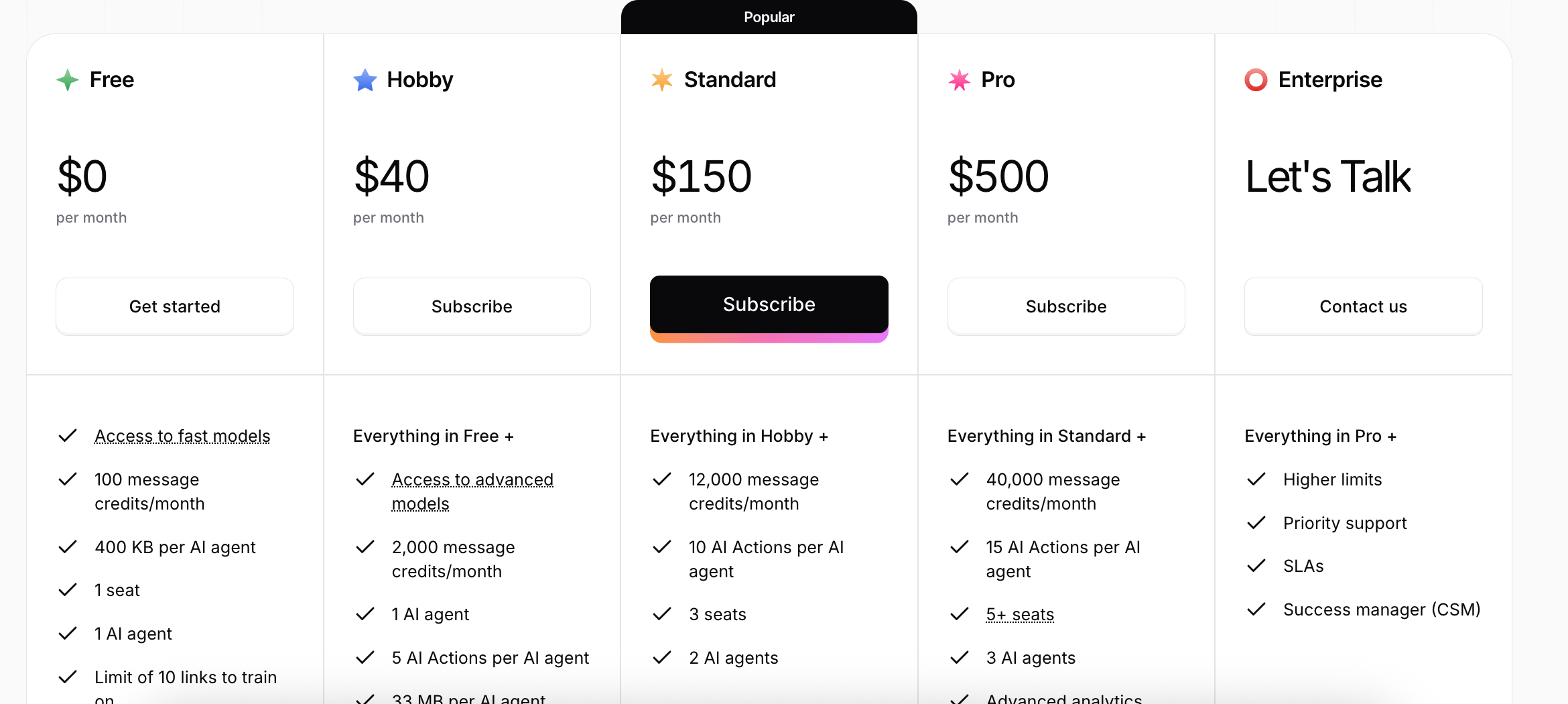
- Typical plan ranges:
- Entry tier: $0 - $29/month, often with low monthly chat/user limits.
- Mid-tier (pro/business): $49 - $99/month, increases message/user limits, adds integrations.
- Advanced/business: $99 - $399/month. Includes premium features, higher limits, priority support.

- See comparison:
| Tool | Best For | Key Strength | Drawbacks | Pricing |
|---|---|---|---|---|
| CustomGPT | Enterprises, custom AI chat, large data uploads | Flexible data sources, custom flows, API, privacy controls | Requires setup, higher starting price | Starter: $49/mo; Pro: $199/mo; Enterprise: Custom |
| Chatbase | Site owners, fast bot training, SMBs | No-code, white-label, multi-bot setup | Message limits, slower support | Hobby: $19/mo; Standard: $49/mo; Pro: $99/mo; Business: $399/mo |
| Botsonic | Customer support, easy bots | Simple, quick-start, data ingestion | Basic analytics, customization gaps | Free: 1 bot, 1K msgs; Pro: $49/mo; Business: $99/mo |
| Landbot | Lead gen, marketing automation | Visual builder, widget customization | API limits, manual integrations | Starter: $49/mo; Pro: $99/mo; Business: Custom |
| Tidio AI | SMBs, ecommerce | Omnichannel chat, auto-routing | Paywalled integrations | Free (50 chats); Starter: $29/mo; Chatbots: $29/mo |
Key differences between each pricing structure
- CustomGPT: Pricing based on data complexity, chatbot intelligence, and customization. Ideal for businesses managing high-volume or sensitive data and needing advanced controls.
- No code AI chatbots tools: Pricing based on bot/chat/user limits and integrations. Faster for simple use cases or SMB owners.
How generous are each free plans?
- CustomGPT: Free plans not standard, but may offer limited trials or restrictive sandbox.
- No code AI chatbots tools: Most offer generous free tier (1 bot, 50-100 chats/month, limited integrations). Some restrict core features or add platform branding.
How does pricing increase with heavy usage?
- CustomGPT: Steep jumps between tiers, especially for data volume and advanced access. Overages may incur additional fees based on API/chat volume.
- No code AI chatbots tools: Linear or stepwise increases tied to message count, seat number, data sources, or integrations. Exceeding limits triggers required plan upgrades.
Other potential surprises
- Overage charges: Hidden API/data overage fees are common on both sides.
- Branding: Free plans typically include platform branding; removing it often requires a paid plan.
- Data privacy: Full GDPR/enterprise compliance may cost extra on no code platforms.
- Support: Priority support and advanced analytics are usually paywalled tiers.
- Rate limits: Daily/monthly message or user caps can throttle rapid-growth bots if not monitored.
CustomGPT vs no-code AI chatbots: Integrations & workflows
Out-of-the-box integrations
CustomGPT:
Connects directly to platforms like Slack, Microsoft Teams, and popular CRMs. Supports webhooks and API endpoints for advanced integrations. Suitable for teams needing to embed AI into wider digital ecosystems.
No code AI chatbots tools:
Focus on easy plug-and-play with platforms like Facebook Messenger, WhatsApp, and website builders (Shopify, WordPress, Wix). Most offer drag-and-drop interfaces for integrating with business tools like Zapier and Google Sheets. Designed for fast setup and immediate value.
Custom workflow capabilities
CustomGPT:
Allows for complex, multi-step conversation flows with advanced logic. Developers can script custom workflows or trigger external processes using API calls. Ideal for businesses with unique operations, compliance needs, or specific data handling requirements.
No code AI chatbots:
Emphasize visual editors for workflow creation. Offer prebuilt conversation templates, branching logic, and limited custom scripting. Best for common use cases such as lead capture, FAQs, and appointment scheduling where speed and ease outweigh deep customization.
Developer involvement and scalability
CustomGPT:
Requires technical familiarity for deep integrations and custom workflows. Offers robust scalability for businesses expecting to expand functionality over time.
No code AI chatbots:
Minimal technical knowledge needed. Scalability may be limited by platform restrictions or feature ceilings, but setup remains quick for most small to medium applications.
CustomGPT vs no-code AI chatbots: AI capabilities
Choosing between building a custom solution (like CustomGPT) and adopting a no-code AI chatbot tool depends heavily on your technical resources, how deeply you want to customize your bot’s AI, and how much time you’re willing to invest.
Here’s a focused look at their core AI capabilities:
- Training options
- CustomGPT: Enables you to fine-tune language models using your own data. Offers granular control over prompt engineering, retrieval-augmented generation, and response logic.
- No code tools: Generally offer “upload and go” data uploads, FAQ-style training, or simple UI-based learning. Limited or no ability to modify underlying model logic.
- Context handling and personalization
- CustomGPT: Capable of managing deeper context windows, supporting ongoing memory, and delivering highly tailored outputs per user session.
- No code solutions: Store limited session data, with template-based personalization approaches. Context typically resets more frequently between user sessions.
- Integrations with external systems
- CustomGPT: Direct API access allows for custom workflows, integration with CRMs, databases, and advanced data pipelines.
- No code tools: Integration via built-in connectors or Zapier-style plugins. Ideal for common use-cases but may lack support for complex or niche requirements.
- AI guardrails and moderation
- CustomGPT: Lets you define custom guardrails, moderation pipelines, or even append post-processing layers on outputs.
- No code tools: Provide out-of-the-box safety, profanity filters, and business rules. Limited for organizations with strict compliance needs.
Here’s a quick comparison:
| Tool | Best For | Key Strength | Drawbacks | Pricing |
|---|---|---|---|---|
| CustomGPT | Engineering teams, enterprises, regulated orgs | Custom model training, deep integrations, advanced context management | Requires technical resources, slower to launch, higher upfront cost | Custom/quote-based per usage and complexity |
| No code AI chatbots tools | SMBs, non-technical teams, quick launches | Fast setup, easy content uploads, built-in integrations | Limited AI customization, constrained logic, generic responses | Monthly SaaS (typically $30 to $400+ depending on usage) |
For developers and startups deciding between building in-house (CustomGPT) or using a ready-made tool, the core trade-off is ultimate AI flexibility versus speed and convenience.
CustomGPT vs no-code AI chatbots: How customizable are they?
Deep customization with CustomGPT
CustomGPT offers extensive flexibility for building AI chatbots tailored to your use case. Developers get granular control over language models, API integrations, and data sources. You can define custom workflows, embed business logic, and design unique conversational flows. Access to backend code means you can adapt the chatbot to fit specific tech stacks and compliance requirements. CustomGPT is preferred when data privacy, branding, and unique functionality are a priority.
Rapid iteration with no-code AI chatbot solutions
No code platforms focus on simplicity and speed. They offer visual editors, prebuilt templates, and point-and-click integrations. Users can deploy chatbots quickly, automate common responses, and update workflows without programming skills. However, customization is limited by platform features. Advanced logic, integrations beyond what's supported, and custom UI changes are often restricted or unavailable.
Choosing the right fit for your startup or team
If your project demands deep integration, custom workflows, and full control, CustomGPT is more appropriate, but it requires developer resources.
If you need a fast, low-cost launch and can work within platform constraints, no-code AI chatbot tools offer a practical solution.
Both approaches can save time over building entirely in-house, but the right choice depends on the technical complexity and how much you need to tailor the chatbot experience.
CustomGPT vs No-code AI chatbots' reviews: What do customers say?
TL;DR →
CustomGPTs gets positive marks for deep customization, control, and handling complex use cases, but has a steeper learning curve and some setup headaches. No code AI chatbot tools win with ease of use and speed for rapid launch, but hit limits on flexibility and integration complexity as needs grow.
Here are their latest scores from major review platforms:
CustomGPT’s average G2 score: 4.6/5 ⭐
CustomGPT’s average Capterra score: 4.8/5 ⭐
No code AI chatbots (averaging Big Sur AI, Chatbot.com, Landbot, ManyChat):
Chatbot.com G2 score: 4.5/5 ⭐
Landbot G2 score: 4.7/5 ⭐
ManyChat G2 score: 4.6/5 ⭐
Across social media and Reddit, the conversation is active among developers and founders debating both options. Here’s what stands out:
CustomGPT: The good
GPTs reviews highlight flexibility, advanced custom datasets, and API power:
“Botpress lets us fine-tune responses on our proprietary data in a way no simple chatbot builder ever could.”
Many devs praise its detailed documentation and support:
"Support is responsive and the docs are much better than with most LLM-based tools I’ve tried."
Others mention the ability to deliver specific answers and control outputs:
“Our legal team was impressed by how we could restrict certain output types—you really can build to spec.”
CustomGPT: The bad
Several reviews cite complexity and onboarding frictions as the main pain:
“Took more time than expected to deploy our first bot, but eventually the results matched what we needed.”
Non-technical users struggle with the interface and terminology:
"I wish the config dashboard wasn’t so developer-centric. A simplified UI would go a long way."
A few mention API limits and pricing surprises at high usage:
“We hit rate limits sooner than we thought, and scaling up got expensive.”
No code AI chatbots: The good
The strongest praise centers on rapid deployment and accessibility for non-technical teams:
"We went from zero to live bot in 30 minutes, and marketing can tweak it without asking engineering."
People reference drag-and-drop editors and visual flows as a differentiator:
“Landbot’s UI is like building a flowchart for conversations—super intuitive.”
Templates for sales, support, and lead gen are recognized as useful jumping-off points:
“There’s a template for pretty much every SaaS use case. No need to reinvent the wheel.”
No code AI chatbots: The bad
Common drawbacks pop up around customization ceiling and handling unusual logic:
“Great for FAQs and basic support—struggled when we needed dynamic document lookup or detailed workflows.”
Integration depth (with custom data sources or internal tools) is a sticking point:
“We couldn’t connect to our internal database without seriously jury-rigging things.”
Pricing jumps for higher usage tiers and paid add-ons also frustrate some startups:
“Starts cheap, but costs balloon quickly as you add users or channels.”
For devs and startups, the decision often comes down to whether you need to control every detail or just want to ship fast with good-enough AI. Both tools shine in their sweet spot.
CustomGPT vs No code AI chatbots: Pros and Cons for each
TL;DR:
💻 CustomGPTs are best suited for teams with developer resources that need deep customization, control, or to integrate unique workflows. It offers total flexibility and ownership but usually requires higher up-front investment and ongoing maintenance.
⚡️ No-code AI chatbots excel for businesses that prioritize speed, simplicity, and fast ROI. They enable anyone to create customer-facing bots in minutes, but are limited in complex integrations and custom AI behavior.
| Tool | Best For | Key Strength | Drawbacks | Pricing |
|---|---|---|---|---|
| CustomGPT | Devs, startups with unique workflows, enterprise with strict compliance | Custom logic, advanced integration, full data control, extensibility | Requires dev skills, high initial setup, ongoing maintenance | Open source/self-hosted: Free+infra; Managed: Custom pricing |
| No code AI chatbots | Solo founders, SMBs, non-technical staff, rapid MVPs | Fast deployment, simple UI, maintenance-free, rich templates | Limited backend integration, less customization, vendor lock-in | Freemium: from $0/mo; Tiered/monthly: $19–199/mo+ |
For most startups, start with no-code tools to validate, then graduate to CustomGPT if scale or complex needs emerge.
The bottom line: Which tool is better for my business?
- Choose Custom GPTs if you need deep customization, advanced AI capabilities, and full control over your chatbot’s data, workflows, and integrations. It’s best for businesses with developer resources, regulated industries, or teams requiring tailored conversation logic, custom compliance, or integration with internal tools. Expect higher setup effort and cost but maximum flexibility and scalability.
- Choose no-code AI chatbots if you want to launch fast, minimize technical effort, and value ease-of-use and lower predictable costs. These platforms excel for SMBs, solo founders, marketers, and non-technical teams who need to deploy website/support bots, automate FAQs, or validate ideas with minimal setup and no coding. You get rapid ROI and rich visual editors but are limited in complex data handling and customization.
- If your team wants minimal setup, instant multilingual support, analytics, and flat pricing, Big Sur AI provides a unique no-onboarding, plug-and-play platform. You’ll be live in a day with all enterprise-grade features included, making it ideal for support, sales, and scaling up without dev cycles or surprise costs.
Give Big Sur AI a try today at https://hub.bigsur.ai/login


